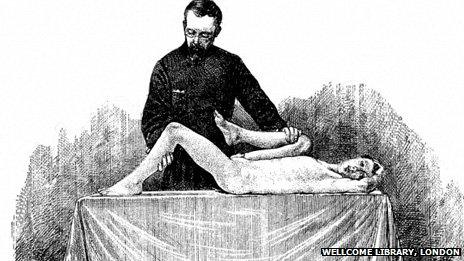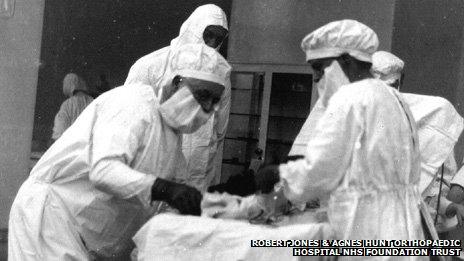DNA unravels clues to shipwrecked Anglesey bone setter
- Published

Hugh Owen Thomas has been called the father of modern orthopaedics Courtesy of images.wellcome.ac.uk
DNA mapping has shed light on a 260-year-old mystery of the origins of a child shipwrecked on Anglesey, who helped shape medical history.
The boy of seven or eight, who could not speak English or Welsh, washed up on the north Wales coast with his brother between 1743 and 1745.
Named Evan Thomas, he was adopted by a doctor and went on to show bone setting skills never seen before in the UK.
Now a DNA study has revealed he came from the Caucasus Mountains.
The boys' dark skin and foreign language led people to believe they were Spanish - a myth which went on for hundreds of years.
Evan's brother survived only a few days, but he went on to demonstrate he already possessed bone setting skills, including the first recorded use in Britain of traction and splints to pull apart the over-lapping edges of breaks and immobilise limbs while healing took place.
'Heavily influenced'
Analysis of DNA from the 13th generation of Evan's descendants is now indicating that the brothers came from an area of the Caucasus Mountains, including Georgia, Ossetia and Southern Russia.
Anglesey bone setter DNA project director John Rowlands said: "When we embarked on the project, all the historical evidence seemed to point to Spain as being the most likely origins of Evan Thomas.
"Not only was there his exotic appearance and language, but also the fact that many Spanish ships were sailing past Wales at the time of the shipwreck, in order to supply troops in support of the Jacobite rebellion in Scotland.
"But early on in the analysis we were able to rule out British or Spanish descent, and now, after studying 300 gigabytes of data, our team at Edinburgh University have found 48 out of 51 points of similarity with DNA originating in the Caucasus.
"It's not yet a perfect match, but you can definitely say that their background was heavily influenced by this region.
"It may be that their family moved away before the boys were shipwrecked, but if so it wasn't more than a generation or so before."

Sir Robert Jones - Evan's great-great grandson - operating in the early 1900s
Wherever his DNA came from, Evan Thomas clearly had a profound effect on his descendants as for the next 12 generations, at least one of them worked in orthopaedics.
Hit the headlines
His great-grandson, Hugh Owen Thomas, earned himself the epithet of The Father of Modern Orthopaedics, after inventing a collar to treat osteo-tuberculosis, a wrench for reducing dislocations, and a splint, which greatly reduced deaths from fractures among late 19th Century Liverpool dockers.
However, it was his nephew, Sir Robert Jones - Evan's great-great-grandson - who would demonstrate the true potential of the Thomas splint - using it on the Western Front, to reduce fracture deaths from 80% in 1916, to just 8% by the end of World War I.
Sir Robert also hit the headlines in 1896 when he became the first doctor to use X-rays to diagnose a fracture, and was the co-founder of the Robert Jones and Agnes Hunt Orthopaedic Hospital in Gobowen, Shropshire.
But Dafydd Evans, from Anglesey, the man whose DNA helped unravel Evan Thomas's secret, has said previously that the family legacy may finally be coming to an end. His sister is a radiologist, and a cousin is a doctor, but he is a retired head teacher.
According to Mr Rowlands, the hunt for a more precise origin goes on.
"It may be that there's a hiatus for months, or even years now, until a DNA sample turns up, which has more than 48 points of similarity.
"But we're on the system now, and sooner or later a closer match will emerge which is something we're all very excited about.
- Published9 November 2011